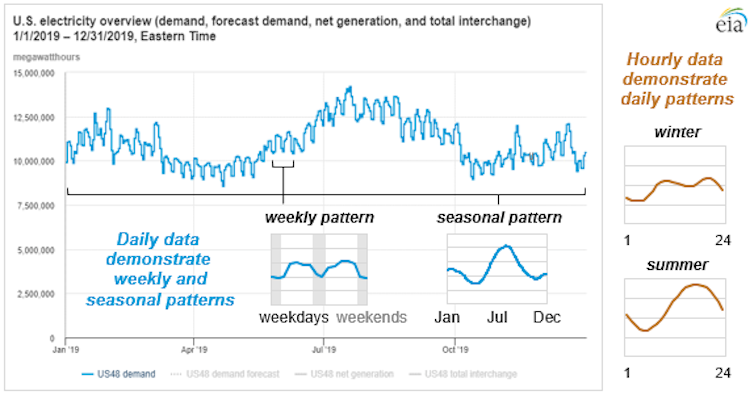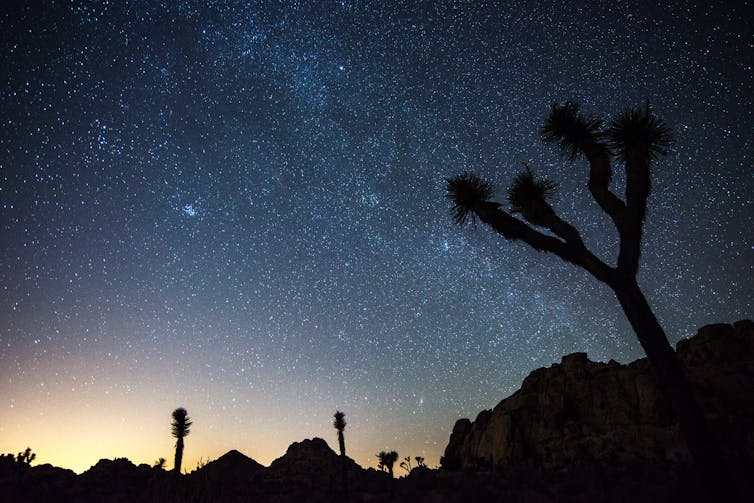The biggest effect of everyone turning lights on at once would be a surge in demand for electricity, which most people worldwide use to operate their lights.
Electricity is a form of energy that is made using many different fuels. Power plants are electricity factories that generate electricity from sources including coal, natural gas, uranium, water, wind, and sunlight. Then they feed it into a network of transmission and distribution wires called the power grid, which delivers the electricity to homes and businesses.
To keep the grid stable, electricity must be supplied on demand. When someone turns on a light, they draw power from the grid. A generator must immediately feed an equal amount of power into the grid. If the system gets out of balance, even for a few seconds, a blackout can happen.
System operators use sensors and sophisticated computers to track electricity demand so they can adjust power production up or down as needed. Total power demand, which is called load, varies a lot from hour to hour and season to season.
Related: Streetlights Could Be Causing Insects to Starve, Scientists Warn
To see why, think of how much electricity your home uses during the day compared with the middle of the night, or during a summer heat wave compared with a cool fall day.

Meeting a demand spike
If everyone turned on their lights all at once around the world, they would create a huge, sudden demand for electricity. Power plants would have to ramp up generation very quickly to avoid a system crash. But these plants respond to changing demand in different ways.
Coal and nuclear plants can provide lots of electricity at almost any time, but if they're shut off for maintenance or they malfunction, they can take many hours to bring back online. They also respond slowly to load changes.
Power plants that burn natural gas can respond more quickly to changing load, so they typically are the tool of choice to cover periods when the most electricity is needed, such as hot, sunny summer afternoons.
Renewable electricity sources such as solar, wind and water power produce less pollution but are not as easily controlled. That's because the wind doesn't always blow at the same speed, nor is every day equally sunny in most places.
Grid managers use large batteries to smooth out power flow as demand rises and falls. But it's not yet possible to store enough electricity in batteries to run an entire town or city. The batteries would be too expensive and would drain too quickly.
Some hydropower operators can pump water into lakes during periods of low demand, then release that water to generate electricity when demand is high by running it through machines called turbines.
Fortunately, if everyone turned on their lights at once, two things would work to prevent a total system crash. First, there is no single worldwide power grid. Most countries have their own grids, or multiple regional grids.
Neighboring grids, such as those in the United States and Canada, are typically connected so that countries can move electricity across their borders. But they can disconnect quickly, so even if the power went out in some areas, it's unlikely that all the grids would crash at once.
Second, over the past 20 years, light bulbs called LEDs have replaced many older electric lights. LEDs operate differently from earlier light bulb designs and produce much more light from each unit of electricity, so they require much less power from the grid.
According to the US Department of Energy, using LED bulbs saves the average household about US$225 yearly. As of 2020, nearly half of all US homes used LEDS for most or all of their lighting needs.

More glare, fewer stars
Beyond powering lights, it's also important to think about where all that light would go. A big spike in lighting would dramatically increase sky glow − the hazy brightness that hangs over towns and cities at night.
Sky glow happens when light reflects off haze and dust particles in the air, creating a diffuse glow that washes out the night sky. Light is very difficult to control: For example, it can reflect off bright surfaces, such as car windows and concrete.
Lighting is often overused at night. Think of empty office buildings where lights burn around the clock, or street lights that shine upward instead of down on streets and sidewalks where illumination is needed.

NPS/Lian Law
Even well-designed lighting systems can add to the problem, making cities and highways visible from space and the stars invisible from the ground. This light pollution can harm human health by interfering with our bodies' natural sleep and waking cycles. It can also disorient insects, birds, sea turtles and other wildlife.
If people worldwide all turned on their lights at once, we'd see a modest increase in power consumption, but a lot more sky glow and no stars in the night sky. That's not a very enticing view. ![]()
Harold Wallace, Curator, Electricity Collections, National Museum of American History, Smithsonian Institution
This article is republished from The Conversation under a Creative Commons license. Read the original article.
